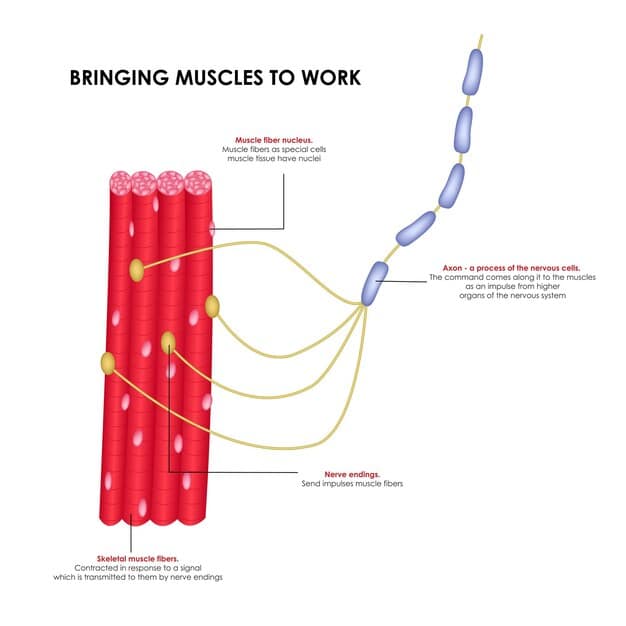Boost Muscle Growth: 15% Protein Increase in 3 Months

Achieving significant muscle growth can be effectively accelerated by a targeted 15% increase in daily protein intake over a three-month period, bolstering muscle protein synthesis and facilitating recovery for enhanced gains.
For anyone serious about transforming their physique and optimizing athletic performance, the role of nutrition is paramount. While exercise creates the stimulus for growth, it is the building blocks supplied by your diet that ultimately dictate the extent of your gains. Among these, protein stands unrivaled as the king of macronutrients for muscle development. But what if a precise, relatively modest adjustment could unlock remarkable progress? Let’s explore How a 15% Increase in Protein Intake Can Boost Your Muscle Growth in 3 Months, delving into the science and practical strategies to achieve tangible results.
The Science of Protein and Muscle Growth
Muscle growth, or hypertrophy, is a complex biological process that involves a delicate balance between muscle protein synthesis (MPS) and muscle protein breakdown (MPB). For muscles to grow, MPS must consistently exceed MPB. Protein, composed of amino acids, provides the essential raw materials for this synthesis. When you consume protein, your body breaks it down into amino acids, which are then used to repair damaged muscle fibers and build new ones, leading to increased muscle mass and strength.
Understanding the role of protein in muscle repair and growth is fundamental. Intense physical activity, particularly resistance training, causes micro-tears in muscle fibers. These micro-tears are not inherently bad; rather, they are the stimulus for adaptation. The body responds by repairing these fibers, making them stronger and larger to better withstand future stress. This repair process is highly dependent on the availability of amino acids. Without adequate protein intake, the body’s ability to recover and adapt is significantly compromised, hindering progress.
Protein Synthesis and Anabolism
The anabolic state, crucial for muscle growth, is directly influenced by protein availability. Anabolism refers to the metabolic processes that construct molecules from smaller units. In a state of anabolism, your body is building and repairing tissues, including muscle. Conversely, catabolism is the breakdown of complex molecules. Optimal protein intake helps maintain an anabolic environment, minimizing muscle breakdown and maximizing muscle building.
- Increased MPS: Adequate protein ensures a steady supply of amino acids, constantly signaling muscle protein synthesis.
- Reduced MPB: Protein aids in preserving existing muscle tissue, especially during periods of calorie deficit or intense training.
- Enhanced Recovery: Quicker recovery from workouts means you can train more frequently and effectively, driving further adaptation.
The quality of protein also matters. Complete proteins, found in animal products like meat, eggs, and dairy, contain all nine essential amino acids that the body cannot produce on its own. Plant-based proteins, while beneficial, often lack one or more essential amino acids, necessitating careful combination to achieve a complete profile. This foundational understanding sets the stage for how a strategic increase in protein can profoundly impact your gains.
In essence, protein isn’t just about feeding your muscles; it’s about providing the critical machinery for them to repair, adapt, and grow. A consistent and sufficient protein supply ensures your body is always in a readiness state to build, rather than break down, muscle tissue.
Establishing Your Baseline Protein Intake
Before implementing a 15% increase, it’s crucial to understand your current protein consumption. Many individuals underestimate their daily intake, which can be a primary limiting factor for muscle growth. Establishing a baseline provides a starting point and allows for precise adjustments. This step involves a bit of self-assessment and tracking, but the insights gained are invaluable.
To accurately determine your baseline, consider tracking your food intake for a few days, ideally including both training and rest days. Utilize a food tracking app or a detailed journal to log everything you consume. Pay close attention to the protein content of each meal and snack. This exercise will reveal your average daily protein intake and highlight any specific times of day where protein consumption might be lacking.
Calculating Your Current Intake
- Food Journaling: For 3-5 days, meticulously record all food items and their respective protein content.
- Nutrition Apps: Use reliable apps like MyFitnessPal, Cronometer, or similar tools that have extensive food databases.
- Read Labels: Always check nutrition labels for packaged foods to determine protein per serving.
Once you have an average daily protein number, you can then calculate what a 15% increase would look like for you. For example, if your current intake is 120 grams of protein per day, a 15% increase would mean adding an extra 18 grams, bringing your new target to 138 grams per day. This measured approach ensures you’re making an informed and effective adjustment, rather than simply guessing.
It’s important to remember that individual protein needs vary based on factors such as body weight, activity level, training intensity, and overall fitness goals. While general guidelines exist, an accurate baseline assessment personalizes the approach, making the subsequent 15% increase more impactful and tailored to your specific needs.
Strategies for a 15% Protein Increase

Implementing a 15% increase in protein doesn’t require a complete overhaul of your diet. Small, strategic adjustments throughout the day can easily help you reach your new target. The key is to integrate protein-rich foods into meals and snacks where they might currently be insufficient. This approach is more sustainable and less disruptive than drastic changes.
Consider starting your day with a protein-rich breakfast. Instead of sugary cereals, opt for Greek yogurt with berries, scrambled eggs with vegetables, or a protein smoothie. These choices not only provide a significant protein boost but also help with satiety, reducing the likelihood of unhealthy snacking later in the morning. Spreading protein intake throughout the day is generally more effective for muscle protein synthesis than consuming large amounts in one or two sittings.
Smart Protein Additions to Meals
- Breakfast Boost: Add a scoop of protein powder to oatmeal, blend into a smoothie, or include eggs.
- Lunch and Dinner: Increase portion sizes of lean meats, fish, beans, or lentils. Add cottage cheese or tofu to salads.
- Snack Smarter: Opt for high-protein snacks like nuts, seeds, cheese sticks, hard-boiled eggs, or protein bars.
Supplementation can also play a role, especially for those with busy schedules or specific dietary preferences. Whey protein, casein protein, or plant-based protein powders offer a convenient and efficient way to boost protein intake without adding excessive calories or volume. However, prioritize whole food sources whenever possible, as they provide a broader spectrum of nutrients. Remember, the goal is not just more protein, but quality protein that supports your overall health and muscle-building efforts.
Consistency is paramount. Making these small, incremental changes daily will add up significantly over three months. This mindful approach to your protein intake ensures you are consistently fueling your muscles for optimal growth and recovery.
Optimizing Protein Absorption and Utilization
Simply increasing protein intake isn’t enough; your body must also effectively absorb and utilize it. Several factors influence how well your body processes protein, from digestive health to nutrient timing. Focusing on these aspects can maximize the benefits of your increased protein consumption, ensuring that every gram contributes to muscle growth and recovery.
Digestive enzymes play a crucial role in breaking down protein into usable amino acids. If your digestive system isn’t functioning optimally, you might not be fully absorbing the protein you consume. Supporting gut health through a diet rich in fiber, probiotics, and prebiotics can enhance nutrient absorption, including protein. Staying well-hydrated also aids in digestion and nutrient transport.
Factors Influencing Protein Utilization
- Digestive Health: Ensure a healthy gut microbiome for efficient protein breakdown and absorption.
- Nutrient Timing: Distribute protein intake evenly throughout the day, especially around workouts, to optimize MPS.
- Complementary Nutrients: Pair protein with carbohydrates to replenish glycogen stores and facilitate amino acid uptake.
While the concept of an “anabolic window” post-workout has been refined, consuming protein shortly after training remains beneficial. This helps kickstart the repair process when muscles are most receptive. Pairing protein with carbohydrates in your post-workout meal or shake can further enhance recovery by replenishing glycogen stores and creating an insulin response that drives amino acids into muscle cells.
Adequate sleep is another often-overlooked factor. During deep sleep, the body releases growth hormone, which is essential for muscle repair and growth. Without sufficient rest, even optimal protein intake won’t yield maximum results. By addressing these various elements, you create an environment where your increased protein intake can truly shine, leading to superior muscle growth over the three-month period.
Consider the cumulative effect: a well-digested protein, timed effectively around training, with the right complementary nutrients, and supported by quality sleep, creates a powerful synergy for muscle gain. This holistic approach is what transforms a simple increase in protein into a significant boost in muscle mass.
The Role of Training and Recovery in Muscle Growth
While increasing protein intake is a critical nutritional lever for muscle growth, it cannot act in isolation. The stimulus for muscle hypertrophy primarily comes from effective resistance training, and the actual growth occurs during the recovery phase. These three components—training, protein, and recovery—form an unbreakable triumvirate essential for maximizing gains over a three-month period.
Your training program must be progressive. This means consistently challenging your muscles with increased load, volume, or intensity. Without this progressive overload, your muscles have no reason to adapt and grow. Simply going through the motions won’t cut it. Incorporate compound exercises, focus on proper form, and aim for a balance of strength and hypertrophy-focused training.
Training Principles for Hypertrophy
- Progressive Overload: Routinely increase weights, reps, or sets to challenge muscles.
- Compound Movements: Prioritize exercises like squats, deadlifts, bench presses, and rows that engage multiple muscle groups.
- Consistency: Adhere to your training schedule to provide regular stimuli for muscle adaptation.

Recovery is equally vital. After intense training, your muscles need time to repair and rebuild. This includes adequate sleep, active recovery (light activity that promotes blood flow), and stress management. Overtraining, characterized by persistent fatigue, decreased performance, and increased injury risk, can negate the benefits of even the most optimized protein intake. Listen to your body and incorporate deload weeks or rest days as needed.
The synergy between training, protein, and recovery is powerful. Your increased protein intake provides the necessary amino acids, your training provides the stimulus, and your recovery allows the growth to materialize. Neglecting any one of these pillars will compromise your ability to achieve significant muscle growth within the three-month timeframe. It’s a holistic endeavor, demanding attention to all facets for optimal results.
Think of it as a well-orchestrated symphony where each instrument plays a crucial part. The training sets the rhythm, the protein provides the melody, and recovery brings it all together in a harmonious composition of muscle growth. A consistent effort across all three aspects will yield impressive results.
Monitoring Progress and Adjusting Strategies
Embarking on a three-month journey to boost muscle growth with increased protein requires diligent monitoring and willingness to adjust. What works perfectly for one person might need tweaking for another. Tracking your progress allows you to evaluate the effectiveness of your strategy and make informed modifications, ensuring you stay on the right path towards your goals.
Beyond simply logging your protein intake, consider tracking objective measures of muscle growth. This could include body measurements (e.g., circumferences of arms, chest, thighs), changes in body composition (e.g., using DEXA scans or bioelectrical impedance analysis if available), and strength gains in key lifts. Visual progress through photos can also be a motivating and insightful way to track changes over time.
Key Metrics for Progress Tracking
- Body Measurements: Weekly or bi-weekly measurements of key muscle groups.
- Strength Gains: Monitor progressive overload in your lifts (e.g., increased weight or reps).
- Body Composition: Consider professional assessments like DEXA scans for accurate body fat and muscle mass data.
Pay attention to how you feel. Are you recovering well between workouts? Do you feel sustained energy throughout the day? Are you experiencing any digestive discomfort from the increased protein? Your body provides valuable feedback that should guide your adjustments. If you’re consistently feeling bloated or experiencing digestive issues, you might need to spread out your protein intake more, consider different protein sources, or consult with a nutritionist.
Be patient and consistent. Muscle growth is not linear, and there will be periods of slower progress. However, by consistently applying the principles of increased protein, effective training, and adequate recovery, and by regularly monitoring your progress, you set yourself up for significant and sustainable gains over three months. This iterative process of tracking, assessing, and refining is what separates successful muscle-building journeys from stagnant ones.
This dynamic feedback loop ensures that your effort isn’t wasted. By being attentive to your body’s signals and the data you collect, you can fine-tune your approach, guaranteeing that the 15% protein increase is working optimally for your unique physiology and goals.
Potential Challenges and Solutions
While the benefits of increasing protein intake for muscle growth are well-documented, the journey isn’t always without hurdles. Facing potential challenges head-on with practical solutions can make the process smoother and more sustainable, ensuring you stay on track for your three-month goal. Anticipating these issues allows for proactive rather than reactive management.
One common challenge is the feeling of fullness or digestive discomfort, especially when significantly increasing protein from whole food sources. This can be mitigated by spreading protein intake throughout the day across smaller, more frequent meals, rather than consuming massive portions in one sitting. Choosing leaner protein sources can also help reduce the overall calorie and fat content, making meals easier to digest.
Addressing Common Obstacles
- Digestive Discomfort: Break up protein intake into smaller, more frequent meals; consider low-lactose protein options.
- Budget Constraints: Opt for cost-effective protein sources like canned tuna, eggs, legumes, or bulk chicken.
- Flavor Fatigue: Experiment with diverse protein sources, spices, and cooking methods to keep meals exciting.
Another concern can be the cost associated with increased protein consumption, particularly for high-quality animal proteins. Solutions include incorporating more budget-friendly protein sources like eggs, lentils, beans, cottage cheese, or opting for larger cuts of meat when on sale. Plant-based proteins can also be very economical and offer a good source of fiber alongside protein.
Lastly, some individuals might experience “flavor fatigue” when trying to consistently hit their protein targets. This is where creativity in the kitchen comes into play. Experiment with different cooking methods, spices, herbs, and protein sources to keep your diet exciting. Don’t be afraid to try new recipes or even incorporate protein into unexpected dishes, like adding protein powder to baked goods or oatmeal.
By proactively addressing these potential challenges, you can maintain consistency and adherence to your increased protein intake plan. Remember, flexibility and adaptability are key. The goal is to make your dietary changes a sustainable part of your lifestyle, not a temporary burden, ensuring long-term success in your muscle-building endeavors.
| Key Aspect | Brief Description |
|---|---|
| 🍖 Precise Protein Boost | A targeted 15% increase in daily protein intake fuels muscle synthesis. |
| 🧪 Scientific Basis | Adequate protein ensures muscle protein synthesis surpasses breakdown for growth. |
| 🏋️♂️ Holistic Approach | Combine increased protein with progressive training and sufficient recovery. |
| 📊 Track & Adjust | Monitor progress and adapt strategies for optimal, sustainable results. |
Frequently Asked Questions About Protein and Muscle Growth
A 15% increase is a manageable yet significant adjustment for many individuals. It’s often enough to push muscle protein synthesis beyond maintenance levels without causing excessive digestive discomfort or being overly calorific. This modest, targeted boost makes it practical for consistent adherence over three months, leading to noticeable gains without drastic dietary changes.
Absolutely. Prioritizing whole food sources like lean meats, poultry, fish, eggs, dairy, and legumes is ideal for obtaining additional protein. These foods also provide other essential nutrients. Protein supplements can be useful for convenience or to fill gaps, but a diet rich in diverse whole foods should be the foundation of your increased intake strategy.
Visible muscle growth takes time and consistency. While you might notice improved recovery or strength within a few weeks, significant changes in muscle mass typically become apparent over several months. The three-month timeframe allows for cumulative effects of increased protein, consistent training, and adequate recovery to manifest in noticeable physique changes.
For most healthy individuals, high protein intake within recommended ranges (often up to 2.2 g/kg body weight) is safe. Excessive protein beyond what the body can utilize for muscle synthesis may be converted to glucose or fat, potentially leading to increased calorie intake. Individuals with specific kidney conditions should consult a healthcare professional before significantly increasing protein.
While increased protein intake supports muscle growth, it’s crucial to pair it with an effective resistance training program that includes progressive overload. New muscle growth requires a stimulus. Without challenging your muscles through lifting heavier weights or increasing reps, the extra protein won’t have the necessary signal to build new tissue. Both elements are essential for optimal results.
Final Thoughts: Powering Your Progress
The journey to enhanced muscle growth is multifaceted, requiring a harmonious blend of intelligent training, strategic nutrition, and diligent recovery. Among these pillars, the targeted increase in protein intake stands out as a profoundly effective accelerator. As we’ve explored, a modest yet consistent 15% boost in your daily protein consumption, sustained over a three-month period, can unlock significant gains in muscle mass, strength, and overall physique. This isn’t about drastic, unsustainable changes, but rather precise adjustments that empower your body to build and repair more efficiently. By understanding your baseline, integrating smart protein choices, optimizing absorption, and aligning your diet with a progressive training regimen and adequate rest, you create an environment where muscle growth thrives. The path to a stronger, more muscular you is within reach, and with this focused approach to protein, you’re well on your way to achieving remarkable results.





